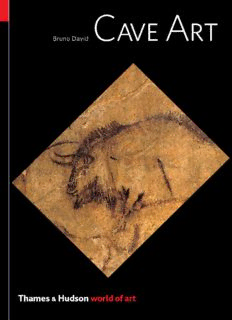
Cave Art PDF
Preview Cave Art
1. Head of a rhinoceros from The Three Rhinoceroses Frieze in the cave of Rouffignac, France. The art remains undated, but through stylistic associations with other, dated Ice Age sites of Western Europe is thought by some researchers to be about 15,000 years old. About the Author Bruno David is Associate Professor in archaeology at the Monash Indigenous Centre, Monash University, Australia. His books include Hiri (with Robert Skelly, 2017), the World Archaeological Congress Handbook of Landscape Archaeology (co-edited with Julian Thomas, 2008), The Social Archaeology of Australian Indigenous Societies (co-edited with Bryce Barker and Ian McNiven, 2006), Landscapes, Rock-Art and the Dreaming (2002), and Inscribed Landscapes (co-edited with Meredith Wilson, 2002). In 1994 he was awarded the inaugural Antiquity Prize for his work on the archaeology of meaning in rock art, in 2007 the Australian Archaeological Association's Bruce Veitch Award for Excellence in Indigenous Engagement, and in 2013 the Ben Cullen Prize for writings on the social construction of caves and rockshelters. His current research involves working in partnership with Indigenous communities in northern Australia and Papua New Guinea, exploring the historical connections that people have formed with places and documenting the antiquity of rock art and its meaning to local communities today. This famous series provides the widest available range of illustrated books on art in all its aspects. To find out about all our publications, including other titles in the World of Art series, please visit www.thamesandhudson.com. There you can subscribe to our e-newsletter, browse or download our current catalogue, and buy any titles that are in print. Other titles of interest published by Thames & Hudson include: The Mind in the Cave: Consciousness and the Origins of Art Inside the Neolithic Mind: Consciousness, Cosmos and the Realm of the Gods The Complete World of Human Evolution The Complete Ice Age: How Climate Change Shaped the World www.thamesandhudson.com www.thamesandhudsonusa.com Contents Chapter 1 Introduction Chapter 2 Discovery Chapter 3 The methods of cave art research Chapter 4 The beginnings of art Chapter 5 The earliest art of modern humans Chapter 6 The art of the Ice Age in Western Europe Chapter 7 Beyond the European Ice Age Notes List of illustrations Acknowledgments Index Copyright For my dear little boy Jasper, who brings joy all day long Chapter 1: Introduction In theory, artists can depict anything they wish, but they don’t. Claire Smith, former President of the World Archaeological Congress1 In 1979 a remarkable discovery deep in the jungles of Guatemala revealed to the world a hitherto unknown underground realm of Maya art. The cave of Naj Tunich [2], in use during the first millennium AD, enticed professional archaeologists and the public alike to imagine a new kind of ancient Maya pilgrimage across cosmic layers beneath an emerald green rainforest roof. Amid hanging stalactites and cavernous passageways, stone altars, smashed ceramic vessels, glyphic inscriptions and curvilinear drawings of women, men and sacred beings in distinctive, contemplative Maya pose [3] gave testimony to a sacred landscape that had remained preserved for centuries. Maya ethnography and ancient writings enabled the art and rituals to be deciphered, a knowledge to which we will return in the final chapter of this book.
Description: